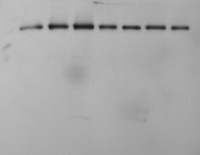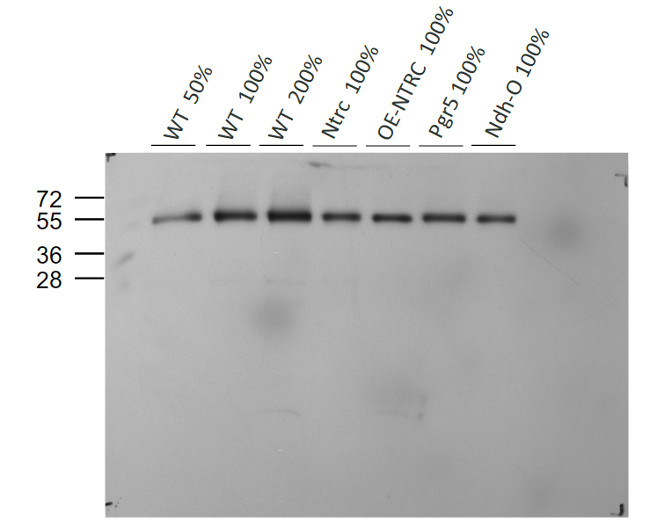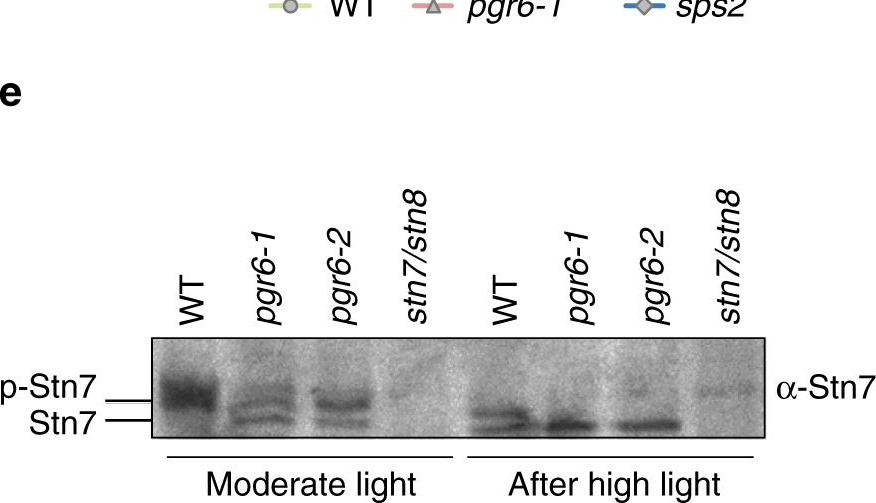1

Anti-STN7, Serine/threonine-protein kinase STN7 (chloroplastic)
AS16 4098 | Clonality: Polyclonal | Host: Rabbit | Reactivity: Arabidopsis thaliana, Nicotiana tabacum
- Product Info
-
Immunogen: KLH-conjugated synthetic peptide specific for Arabidopsis thaliana STN7 serine/threonine kinase, UniProt: Q9S713,
TAIR: At1g68830Host: Rabbit Clonality: Polyclonal Purity: Immunogen affinity purified serum in PBS pH 7.4. Format: Lyophilized Quantity: 50 µg Reconstitution: For reconstitution please add 50 µl of sterile water Storage: Lyophilized antibody can be stored at -20°C for up to 3 years. Re-constituted antibody can be stored at 4°C for several days to weeks. Once reconstituted make aliquots to avoid repeated freeze-thaw cycles. Please remember to spin the tubes briefly prior to opening them to avoid any losses that might occur from material adhering to the cap or sides of the tube. Tested applications: Western blot (WB) Recommended dilution: 1 : 1500 (WB) Expected | apparent MW: 63.2 | 44 kDa (on urea gel), 55 kDa (no urea) - Reactivity
-
Confirmed reactivity: Arabidopsis thaliana, Nicotiana tabacum Predicted reactivity: Anthurium amnicola, Arabidopsis alpina, Capsicum annuum, Dichanthelium oligosanthes, Glycine soja, Gossypium hirsutum, Hordeum vulgare, Medicago truncatula, Morus notabilis, Nelumbo nucifera, Nicotiana sylvestris, Nicotiana tabacum, Noccaea caerulescens, Vigna radiata var. Radiata
Species of your interest not listed? Contact usNot reactive in: Solanum lycopersicum - Application Examples
-
Application example

Isolated thylakoids from Arabidopsis thaliana leaves were extracted with grinding buf fer containing 300mM Sucrose, 50 mM Hepes-NaOH pH 7,4, 5 mM MgCl , 1 mM Na-EDT A containing freshly made 10 mM NaF. Then the 2 chloroplast pellet was dissolved with shock buf fer containing, 5 mM Sucrose, 10 mM Hepes-NaOH pH 7,4, 5 mM MgCl containing freshly made 2 NaF (10 mM), whereafter pellet containing thylakoid fraction was carefully again dissolved in to the storage buf fer containing 100mM sucrose, 10 mM Hepes-NaOH pH 7,4, 10 mM MgCl in the presence of freshly made 10 mM 2 NaF . Protein amounts loaded according to PORRA corresponding to 1, 2, or 4μg of Chlorophyll, and denatured with Laemmli buf fer at C or 65C for 5 min. Proteins were then further separated on 15 % Acryl Amide containing 6M Urea with SDS-P AGE, blotted 1h to PVDF membrane using semi-dry transfer (Hoefer TE77X) followed by rinsing in 1xTBS for 2 min. Membranes were then blocked with 4% Milk in 1XTTBS for 2 hrs at room temperature (R T) with agitation. Blot was then incubated overnight in af finity purified Stn7 primary antibody (Agrisera) at a dilution of 1:1500 for 18hrs at +4C with slow agitation in 1% Milk, 1XTTBS. The antibody solution was collected, and the blot was rinsed 5 minutes 3 times each with 1x T-TBS at RT with agitation. Blot was incubated with HRP conjugated conjugated goat anti-rabbit IgG secondary antibody (Agrisera, AS09 602) diluted to 1:25 000 in 1% Milk, 1XTTBS for 2hrs at R T with agitation. The blot was washed 10 min in 1X TTBS, with additional washes of 4X4 min in 1XTBS. Blot was then incubated in ECL solution for 5 min. Film was exposured for 2minutes.Courtesy of Dr. Jouni Tivola, University of Turku, Finland
Application examples: 
Reactant: Arabidopsis thaliana (Thale cress)
Application: Western Blotting
Pudmed ID: 31240258
Journal: Commun Biol
Figure Number: 2e
Published Date: 2019-06-27
First Author: Pralon, T., Shanmugabalaji, V., et al.
Impact Factor: None
Open PublicationThylakoid protein phosphorylation and state transitions are disturbed after high light treatment in pgr6 background. a Total protein extracts of 4-week-old wild type (WT), pgr6-1, pgr6?2, sps2 and stn7/stn8 analysed by immunoblotting with anti-phosphothreonine antibody; the principal thylakoid phospho proteins are indicated on the right according to their size. Core photosystem II proteins D1 (PsbA) and D2 (PsbD) are indicated as a single band due to their poor resolution. Actin was used as a loading control. b Lhcb1 and Lhcb2 phosphorylation levels were visualised after separation on Phostag™-pendant acrylamide gels. The upper band corresponds to the phosphorylated form (p-), stn7/stn8 double mutant is a non-phosphorylated control. c Average transient of the variable room temperature chlorophyll fluorescence measured during the transition from red (660nm) supplemented with far-red light (720nm) state 1 to pure red light state 2 (n?=?4 independent pots containing 2–3 plants). The fluorescence curves from pgr6 and sps2 are shifted on the x-axis to allow visualising the FMST1 and FMST2 values. The x-axis time scale refers to the wild-type curve. d Calculated quenching related to state transition (qT?=?(FMST1?–?FMST2)/FM), expressed as the percentage of FM that is dissipated by the state 1 to state 2 transition, of wild type (WT), pgr6?1 and sps2 under moderate light (120?mol?m?2?s?1) (ML) and after 3?h of high light (500?mol?m?2?s?1) (HL). Whiskers and box plot shows the minimum, first quartile, median, average, third quartile and maximum of each dataset (n?=?4 biologically independent samples); p-values are calculated via a two-tailed Student’s t test. e STN7 phosphorylation level visualised after separation on Phostag™-pendant acrylamide gels. The upper band corresponds to the phosphorylated form (p-), a protein sample from stn7/stn8 double mutant was loaded as a control for the antibody specificity. Uncropped images of the membranes displayed in a, b and e are available as Supplementary Fig. 11. Data points for items c, d are available as Supplementary data 2
- Background
-
Background: STN7 (serine/threonine protein kinase) (EC=2.7.11.1) in Arabidopsis thaliana, and its Stt7 homologue in Chlamydomonas reinhardtii, is required for LHCII phosphorylation and for state transitions. The loss of this thylakoid-associated kinase blocked stn7 (stt7)-deficient mutants in state 1. Alternative names: Protein STATE TRANSITION 7, Stt7 homolog. - Product Citations
-
Selected references: Mazur et al. (2021) The SnRK2.10 kinase mitigates the adverse effects of salinity by protecting photosynthetic machinery. Plant Physiol. 2021 Dec 4;187(4):2785-2802. doi: 10.1093/plphys/kiab438. PMID: 34632500; PMCID: PMC8644180.
Pralon et al. (2019). Plastoquinone homoeostasis by Arabidopsis proton gradient regulation 6 is essential for photosynthetic efficiency. Commun Biol. 2019 Jun 20;2:220. doi: 10.1038/s42003-019-0477-4.
Ancin et al. (2019). Overexpression of thioredoxin m in tobacco chloroplasts inhibits the protein kinase STN7 and alters photosynthetic performance. J Exp Bot. 2019 Feb 5;70(3):1005-1016. doi: 10.1093/jxb/ery415.
Rudenko et al. (2019). The role of carbonic anhydrase ?-CA4 in the adaptive reactions of photosynthetic apparatus: the study with ?-CA4 knockout plants. Protoplasma (2019). https://doi.org/10.1007/s00709-019-01456-1
Nikkanen et al. (2018). Multilevel regulation of non-photochemical quenching and state transitions by chloroplast NADPH-dependent thioredoxin reductase. Physiol Plant. 2018 Dec 22. doi: 10.1111/ppl.12914.
Ancin et al. (2018). Thioredoxin m overexpression in tobacco chloroplasts inhibits the protein kinase STN7 and alters photosynthetic performance. J Exp Bot. 2018 Nov 21. doi: 10.1093/jxb/ery415. - Protocols
-
Agrisera Western Blot protocol and video tutorials
Protocols to work with plant and algal protein extracts
Oxygenic photosynthesis poster by prof. Govindjee and Dr. Shevela
Z-scheme of photosynthetic electron transport by prof. Govindjee and Dr. Björn and Dr. Shevela - Reviews:
-
Vasily Terentyev | 2018-06-27The antibodies worked very well with thylakoid samples from Arabidopsis. They showed clean single band with using delution 1:10 000 (with ECL reagents). We changed only one specific step from standart protocol - we incubated the membrane with primary antibodies overnight at 4C.
In the final we clearly saw the difference between mutans and wid type of Arabidopsis. The signal was strong enough.



